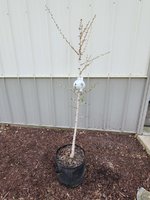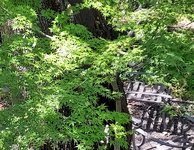You are using an out of date browser. It may not display this or other websites correctly.
You should upgrade or use an alternative browser.
You should upgrade or use an alternative browser.
Maple air layer fail.
- Thread starter Nor Cal AC
- Start date
19Mateo83
Masterpiece
What type of maple is it? Some cultivars of Japanese maples just will not strike roots.Well.. it's official. I have tried to air layer the same tree three years in a row, and have had the same result every time. The leaves dry up and die within 4 weeks. I think this tree hates me!!. View attachment 433308
Nor Cal AC
Mame
Shibui
Imperial Masterpiece
No mention of your technique so we cannot assess whether there's any obvious issues there. If you think this has truly failed you could unwrap and take some good, clear pics of the site and add some commentary on what you id and when. Someone may be able to pick something up and suggest changes.Well.. it's official. I have tried to air layer the same tree three years in a row, and have had the same result every time. The leaves dry up and die within 4 weeks. I think this tree hates me!!.
As mentioned, some JM are just very resistant to growing new roots and this may be one of them.
I'd certainly admit defeat after 4 failed attempts.
LittleDingus
Omono
I agree with Shibui...pictures could help identify if your technique is sound.
Leaves on a layer shouldn't brown and dry up. The whole basis of a proper air layer is to leave the upward water transport layers. It's the downward sap layers we're trying to break.
I just cut off a ginkgo layer that has survived 2 winters and leafed out after each one. After the first winter, there were zero roots on the layer but since it leafed our, I left it. Yesterday, after winter 2, this is what the layer looked like.


It did not bridge...though it is getting close. You can see that the tree above the layer is starting to bud out.
If the leaves above the layer are dying, I would take a closer look look at technique.
Leaves on a layer shouldn't brown and dry up. The whole basis of a proper air layer is to leave the upward water transport layers. It's the downward sap layers we're trying to break.
I just cut off a ginkgo layer that has survived 2 winters and leafed out after each one. After the first winter, there were zero roots on the layer but since it leafed our, I left it. Yesterday, after winter 2, this is what the layer looked like.


It did not bridge...though it is getting close. You can see that the tree above the layer is starting to bud out.
If the leaves above the layer are dying, I would take a closer look look at technique.
Srt8madness
Omono
Glad this was posted, I had an air layer fail last year (dead leaf issue). Now i realize I probably dug too deep into the tree.
19Mateo83
Masterpiece
Do air layers take on downward pointing branches?
Dav4
Drop Branch Murphy
- Messages
- 13,098
- Reaction score
- 30,137
- USDA Zone
- 6a
The more vigorous the branch, the higher the chances of success. Direction shouldn't matter, but most trees want to grow up and a branch growing downward sounds like it's searching for sunlight while being shaded from above.Do air layers take on downward pointing branches?
Fwiw, I redid two of three layers this week on two 3 year old Arakawa seedlings... plenty of callus but no roots. I cut away all of the callus, making sure I cut below the cambium on both sides of the layer site and used knob cutters to take slightly deeper bites completely around the trunk, applied rooting hormone, then covered up with soil. I'll hopefully see some roots by July.
LittleDingus
Omono
Do air layers take on downward pointing branches?
I placed a layer in the dip of a branch once...the branch came out of the trunk, bent down for a bit then bent back up forming a king of "U" shape.
I put the layer at the bottom of the "U". I got roots on both sides of the layer gap...presumably because the gap was "down" on both sides.
I've never tried to layer anything where the roots needed to form uphill from the branch tip...which is what I think you're meaning by "downward pointing"?
LittleDingus
Omono
Do air layers take on downward pointing branches?
I placed a layer in the dip of a branch once...the branch came out of the trunk, bent down for a bit then bent back up forming a king of "U" shape.
I put the layer at the bottom of the "U". I got roots on both sides of the layer gap...presumably because the gap was "down" on both sides.
I've never tried to layer anything where the roots needed to form uphill from the branch tip...which is what I think you're meaning by "downward pointing"?
19Mateo83
Masterpiece
The lower branches on the October glory maple in my front yard have a downward “weeping” form and I’m giving it a go. I wired a couple of the air layered branches upward and left one or two in the downward position. We will see how it goes. I know the branch tips produce the auxin that is supposed to build up at the cut site and stimulates the formation of roots, what I’m not sure of is if gravity plays a role in its transportation or if it’s all done by the capillaries in the cambium.I placed a layer in the dip of a branch once...the branch came out of the trunk, bent down for a bit then bent back up forming a king of "U" shape.
I put the layer at the bottom of the "U". I got roots on both sides of the layer gap...presumably because the gap was "down" on both sides.
I've never tried to layer anything where the roots needed to form uphill from the branch tip...which is what I think you're meaning by "downward pointing"?
0soyoung
Imperial Masterpiece
Water is drawn up the tree in the wood (xylem) by transpiration in the leaves. So,
Trees compartmentalize damage (CODIT) by creating a seal around the damaged tissues.
 www.bonsainut.com
www.bonsainut.com
means water isn't finding its way to the leaves --> is not finding its way past the region of the girdle.The leaves dry up and die within 4 weeks.
Trees compartmentalize damage (CODIT) by creating a seal around the damaged tissues.
Maple airlayer turning brown
Hi team, around the start of spring (September 15th) I began my first ever airlayer. My Sangu Kaku is a multi leader and a great opportunity for multiple projects. Contrary to my own doubts it has managed to spout roots and leafed out amazingly. Everything was going great, I noticed so solid...
0soyoung
Imperial Masterpiece
There are no capillaries in the cambium. Auxin is conveyed down the tree in a bucket-brigade from one cambium cell to the next, affecting the polar auxin transport (PAT) stream that always goes toward the roots. There are PIN proteins in the cambium cell membranes that make this happen.what I’m not sure of is if gravity plays a role in its transportation or if it’s all done by the capillaries in the cambium.
There is the phenomenon of 'gravitropism' that causes the to be more auxin on the underside of stems. If one bends stems so that they arch down (as in 'pegging' roses) new shoots tend to be released at the top of the arch = basically the same effect as pruning. Bend an azalea stem in the opposite way and burying the bottom of the 'U' will often generate roots at the bottom of the 'U' --> this can happen spontaneously an is how/why many varieties ground layer themselves.
Nor Cal AC
Mame
I will take some pictures today. I have had plenty of success with the technique I use on many other maples.No mention of your technique so we cannot assess whether there's any obvious issues there. If you think this has truly failed you could unwrap and take some good, clear pics of the site and add some commentary on what you id and when. Someone may be able to pick something up and suggest changes.
As mentioned, some JM are just very resistant to growing new roots and this may be one of them.
I'd certainly admit defeat after 4 failed attempts.
Shibui
Imperial Masterpiece
That should be good enough to be confident of technique which just leaves the condition of the parent tree, weather conditions and genetic resistance to growing new roots. The tree looks healthy in the photos so I'd be leaning more towards some predisposition for this particular tree to be reluctant to root which is just plain bad luck as the leaves look good from a bonsai point of view.I have had plenty of success with the technique I use on many other maples.
Maiden69
Masterpiece
Somebody shared this in a different thread. I has a few successful layers, and I think the "even pressure" is key to the success, especially in hard to root trees. Graham doesn't use rooting powder, I do. It gives me a little peace of mind.
Pitoon
Imperial Masterpiece
In my experience with air layering when using sphagnum moss you have to wrap it really tight against the branch/trunk. Your wrap looks very loose.Well.. it's official. I have tried to air layer the same tree three years in a row, and have had the same result every time. The leaves dry up and die within 4 weeks. I think this tree hates me!!. View attachment 433308
Try taking some cuttings. If those cuttings root then there's a high chance you can air layer a branch (maybe a younger branch). If the cuttings fail then it's time to move on to another tree to air layer.
Similar threads
- Replies
- 4
- Views
- 331
- Replies
- 17
- Views
- 1K


